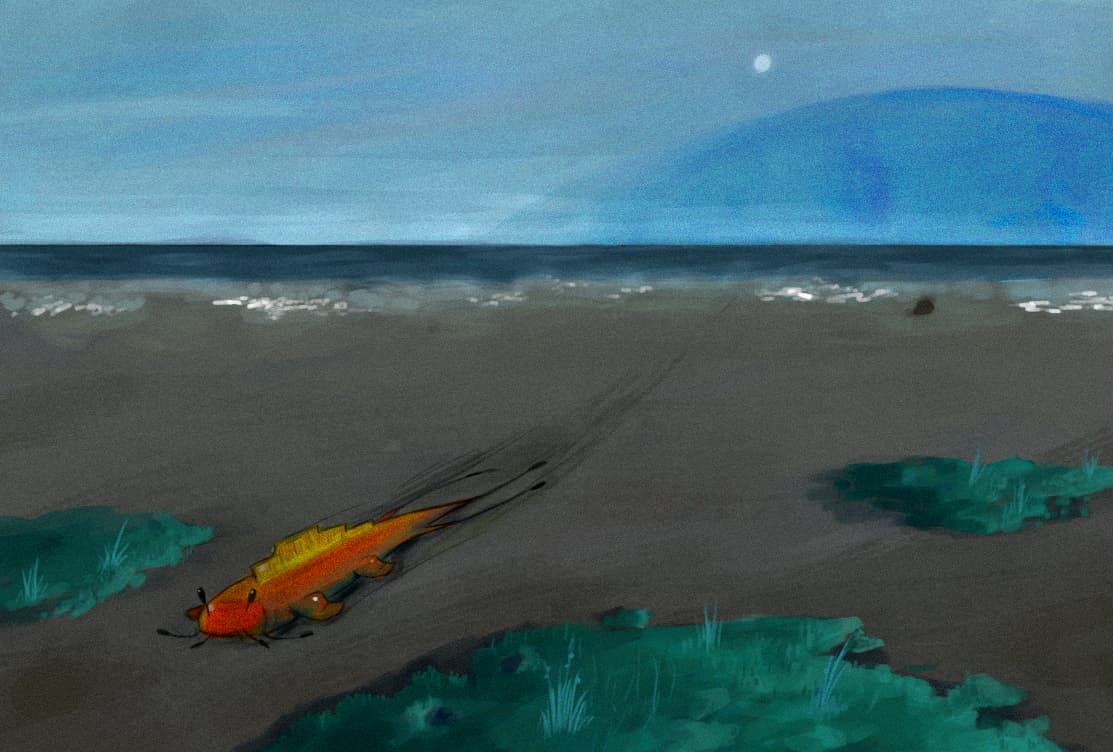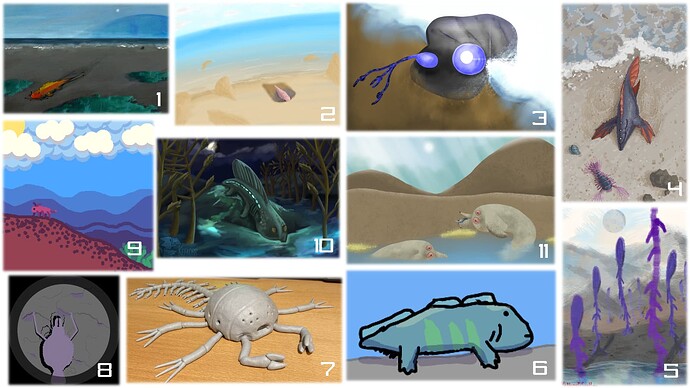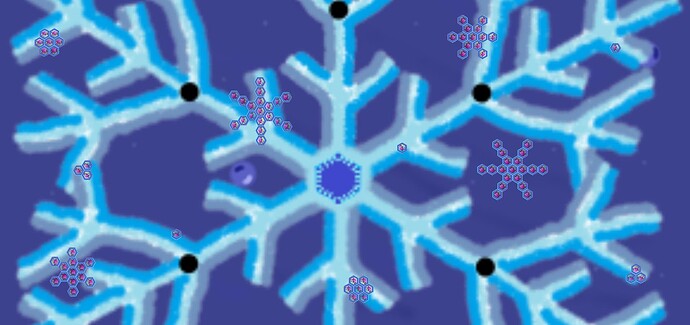that was an accident, actually.
Better late than never!
opave’ỹva is a moon orbiting an massive gas giant roughly the size of Jupiter. Due to a combination of gravitational push, too much water in that solar system region, somewhat young age, and bad luck, 93% of the moon is covered by big, sparse oceans filled with native fauna, flora, and other things human language has no words to.
Due to strong tides, and lack of evolutionary pressure, the native animal life has been quite shy into exploring the scarse landmasses this world has.
Until now.
Millenias upon millenias of being throw at the beach sand, resulted in a certain species to evolve characteristics that help them survive out of water, something that has become crucial to their survival.
However, a particular specimen was chronically curious to learn what is outside the ocean, the comfort of its home.
On a low tide day, they put their little plan into action. With a certain - but necessary - slowness, they moved further and further away from the shore. Their barbers, that had somehow evolved to become almost identical to their eyes in order to scare and confuse predators, dragged along the rough sand of the beach. Their primitive brain would never understand that, but the flame of curiosity they lit up that day,
never went down.
feedbacks are VERY appreciated! :3
From the color of grass I can guess that the star is sol-like. Just how massive is the gas giant?
Looks very nice.
The star is actually a little bigger and younger than the sun, if that weren’t the case I would have painted the plants in a greener tone. I don’t see much spec evo revolving stars bigger than the sun so i tried to do something new.
A tiny bit bigger than jupiter, both in mass as in size.
Thank you!
Oh, I thought that the gas giant would’ve been large and massive enough to leave the rest of that star system with only some dwarf planets. How large is that moon tho?
bettween Mars and Earth size, however the gravity is closer the the earth one due to the amount of water in it.
I guess that this is the largest moon of this planet or is it a captured moon?
Largest moon. there was alot of material in the protoplanetary disk.
Do you have more indepth insight into this world or was it only made for the contest?
That’s really good, I don’t think I’m gonna be winning the competition.
Guess that it’s the time of my own submission.
DESCRIPTION
Caecoreptus Purpurascens (Blind-Crawling Somewhat-Purple) is an arthropod-like organism found in the large subterranean cave systems of a rocky planet in the █ █ █ █ █ █ █ system. The said planet has an atmosphere too thin to support life on the surface, however a large network of caves in the surprisingly porous crust of the planet managed to obtain a far denser and chemically-rich gas composition, with many caves being flooded with water, creating a sort of an “underground ocean”. This environment has been hosting life for roughly █ █ █ █ █ █ █ █ █ years now.
The specified organism, Caecoreptus Purpurascens, is notable for being the first known animal-like species to derive most of it’s food from sources above the water tables of the vast cave systems. An average specimen is roughly 8 centimeters long from tips of the mandibles to the edge of the tail. This species is closely related to a family of far larger, predatory organisms, which is not hard to tell due to the many predator-linked features of this species - the pair of limbs with sharp claws at the end of them and large mandibles with serrations still present on them. It’s thought that this species originated from a more generalist/omnivoreous branch of this family, which started to feed on the various chemosynthesizing organisms found around the caves. This specific species has gone to the extreme, as it most likely started using it’s claw-bearing limbs to start climbing the usually steep shores of the flooded caves to find new sources of food. In a few million years, the species has adapted far more to this lifestyle. The sensory tentacles present around it’s “head” have became longer and stronger to fight against the forces of gravity abovewater. The claws have been repurposed as hooks to secure the creature and pull it. Finally, the respiratory system no longer needs to be submerged in water to properly work, and while it still requires the air around these organisms to be high in moisture, it allows them to venture further into the dry surfaces than any other animal-like organism found on this planet to this point.
Thrive Art Contest - First Terrestrial Organism Wrap-Up ![]()
We’re thrilled to announce that the Thrive Art Contest - First Terrestrial Organism has officially come to an end, and we received 11 incredible submissions!
A huge thank you to all the talented artists who participated, sharing their creativity and unique visions with us! ![]()
Now it’s up to you to choose the winner of this contest
Poll is open until 2024-10-26T14:00:00Z
- 1 - Trappist-1e
- 2 - doomlightning
- 3 - Happie283
- 4 - Zorkman Retired Dev and Mod
- 5 - Nonametoseehere
- 6 - sci0927
- 7 - Rehtom Ruoy
- 8 - aah31415
- 9 - voxelbugged
- 10 - kefkorr
- 11 - Abroba com leite
Edit: apologies for the one vote that was cast already to be lost, there was an editing problem on this post -@hhyyrylainen
Winners have been announced in the devblog: Devblog #44: Oxygenating - Revolutionary Games Studio
For this new competition round you will need to design a unique and visually captivating organism that deals with the coldest of temperatures! Be it artic waters, chilling tundras, gelid glaciers, or whatever you come up with! Your imagination is the limit.
When you are finished, post your submission in the discord channel or our community forums with a short description for your scene before the 8th of February. You’ll have a whole week to vote, results will be given the 15th of february.
If you’d like to be mentioned on our social media, make sure to include your socials!
- The top 3 winning entries will be highlighted on Thrive’s social media and our discord channel
- All participants will get special roles on our Discord server
- All participants will get special titles on the Thrive Community Forums
If you have any questions feel free to ask them on our discord
Good luck and have fun!
Huh, I expected Mr42 to post this annoucement here too as they did on the TCDS.
Nice to see this, I’ll get an another chance atleast…
This time we’ve been working together to bring the competition back!
We also gave more time so we hope to have a lot more amazing participants that will share their incredible art!
Guess I’ll bring back the cave folk…
Edit: Also I can guess the “AC Promoter” image was made by Bolsa, right?
I hope people like my submission; I am not an artist, so I hope it is “good enough” for the art competition.
Description
Psychrosquamus plagahamil (Cold-flat plague-bringer) is an Eukaryotic organism with a unique six-sided symmetry. Combined with their unusual reflective properties, Xenobiologists initially mistook these organisms for Snowflakes. Hence for their common name, Snowflake Mimics.
Snowflake Mimics were discovered in the Ragnarök system underneath the ocean of a recently found Dwarf Planet named Jötunheimr. Being named after the home of the Frost Giants in Norse Mythology, this Dwarf Planet is the approximate size of the Earth, but it was located in Ragnarök’s Kuiper Belt. Like Pluto, Jötunheimr has a thick layer of Nitrogen ice tens of miles thick, and beneath that layer of Nitrogen Ice is an even deeper ocean of liquid water. Due to Jötunheimr’s larger mass, the underwater volcanic activity has injected many important chemicals into this vast ocean, such as Iron and Hydrogen Sulfide.
Like on Earth, life began in the ocean. Mixing of Tholins from surface and chemical below created the perfect conditions for life. After the first drilling probe collected samples of water, Psychrosquamus were discovered in the samples.
Characterization of the membrane has found analogs of Cholesterol, which indicates that this organism may be an animal. However, more mature Pyschrosquamus have vestiges of glide-symmetry within their internal structure, far too much compared to Modern Earth Animals. This has given rise to an idea that they are Ediacaran-like organisms.
There are issues with this hypothesis, despite it being popular with regular folk. Unlike Ediacarans on Earth, the mature stage of a Psychrosquamus has eye-like cells high in retinal analogues located on each “arm” of the mature organism. Also, the mature Pyschrosquamus has a clearly delineated orifice with especially-hardened teeth-like cells.
The nature of these teeth-like cells are unlike anything on Earth. The outer shell of these cells is high in iron, similar to the metallic claws of the fictional character Wolverine. Also, these cells secrete a “seed” protein, which helps crystallize ice shards. It is believed this function is for aiding in biting or hooking prey.
A recent video of the organism in vivo has found another reason: locomotion. Like the intracellular bacterial pathogen Listeria using Actin on Earth, other cells within Pyschrosquamus secrete this “seed” protein for propelling itself using localized ice crystallization and decrystallization. Due to the larger size of the mature organism, this process imparts small, but steady locomotion. At smaller scales, this process imparts quite a bit of speed.
Additionally, these organism have a unique anti-freeze protein which allows them to live in the very cold, upper regions of the underwater ocean. This protein is also the reason for the Psychrosquamus unique ice-like shine and color. Iron and sulfur-bearing proteins are concentrated with individual cells, indicate that this may be a potential food source for the ice-lovers. It is also possible that these organelles with iron are used for direction-sensing with the planet’s magentic field.
Psychrosquamus plagahamil is most studied organism of Jötunheimr. During its lifecycyle, “stem” cells are ejected and are taken by currents. If a “stem cell” of Pyschrosquamus plagahamil attaches itself onto another organism, then it uses the host for nutrients. Otherwise, the cell will wander around and grow until it reaches maturity.
A mature Pyschrosquamus plagahamil is about the size the smallest possible Earth insect (0.5 to 1.0 mm). The plagahamil species is named for the fact that it houses toxins within itself, and the disease this toxin inflicts when injected into a host organism. This toxin is also for defense against being eaten, and the toxin possibly has anti-oxidant properties, but this does not stop organisms that have adapted against the toxin from eating it.
For the plagahamil species, it will either consume organisms smaller than itself, incidentally sometimes its own smaller kind, or attach itself to a bigger organism and leach off of it. When the toxin is inject, it slowly kills the host organism. When one mature Pyschrosquamus plagahamil starts to kill its host, after several days, it secrets a factor into the water to attract other Pyschrosquamus plagahamil to also attach/attack the same target. Eventually, the host organism is covered in Snowflake Mimics, which gorge on the dead host. This behavior gave Pyschrosquamus plagahamil the nickname “Flurries of Death”.
The background “snowflake” is the adult form, right?
Yes. The Background Snowflake is the “adult form”.




